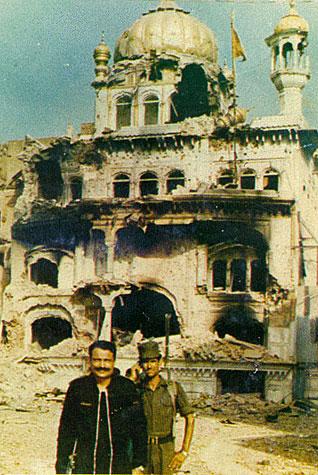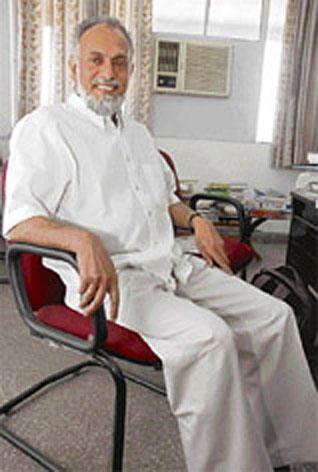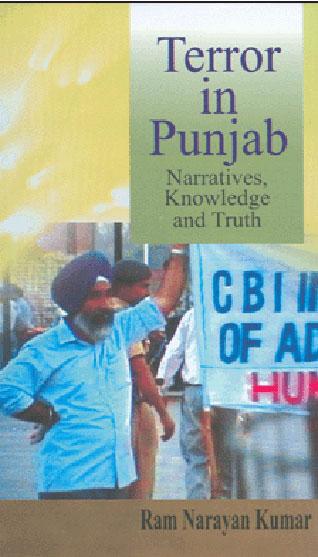1984
The Third Sikh Holocaust:
Ram Narayan Kumar's
Terror in Punjab:
Narratives, Knowledge and Truth
A Book Review by PRITAM SINGH
TERROR IN PUNJAB: NARRATIVES, KNOWLEDGE AND TRUTH, by Ram Narayan Kumar. Shipra Publications, New Delhi, 2008. ISBN: 81-7541-398-6. 378 pages. Price: Rs. 618.
This June marks the 25th anniversary of Operation Blue Star, the fancy name given by the Indian state to the military action it took at Amritsar's Harmandar Sahib, or the Golden Temple, the Sikhs' holiest shrine, starting on 3 June 1984.
A quarter-century on, how do we describe this action, and what meaning do we attach to it?
Do we describe it, as the ideologists of the Indian state continue to do, as a holy task undertaken by the Indian military to clear the temple of the militants who had taken control of it?
Or do we describe it, as some Indian nationalists and leftists do, as a sad and necessary action to defeat an imperialist conspiracy to disintegrate India?
Do we celebrate it, as some Hindu nationalists do, as a successful assertion of India's Hindu strength against the Sikh minority's separatist aspirations?
Or do we condemn it, as Sikh and Punjabi nationalists do, as a genocidal attack on Sikh dignity, assertion and identity?
Perhaps we decry it, as most human-rights defenders and leftists do, as a human tragedy resulting in the deaths of thousands of human beings - pilgrims, sevadars, Sikh combatants and Indian army men.
The contesting descriptions of Operation Blue Star and the meanings attached to it are reflections of serious fault lines in the Indian society and polity. To say that there would never be a consensus on how to describe and signify this military action may be both unreasonable and ahistorical.
But to say that there is little likelihood of a consensus in the foreseeable future would be alluding to an uncomfortable truth about the fractured nature of Indian nationhood. However this operation is described and whatever meaning is subsequently attached to it, one thing is clear: one day, everyone else might want to forget it - and, indeed, might succeed in doing so - but this will never be true of the Sikh community.
Operation Blue Star has become an integral part of the Sikh collective historical memory. It has become the Third Ghallughara (holocaust) in Sikh history - the first referring to the massacre of some 10,000 Sikhs in 1746; the second to the even larger massacre of Sikh men, women and children in 1762, when 30,000, 50 percent of the population, were slaughtered.
Today, evidence gathered by this reviewer suggests that many (though not all) gurdwaras in India and abroad include references to the Third Ghallughara in their daily ardas, or prayers.
The most reliable estimates of the total number of deaths during Operation Blue Star are anywhere from 5000 to 7000. Yet a crucial difference between the Third Ghallughara and the previous two is that this massacre occurred in the Golden Temple, while the first two took place on open battlefields.
This gives added religious dimension to the significance of the military action: a much larger number of Sikhs died during Partition, but the 1947 deaths are not seen in terms of attacks on and in defence of religion. In religious terms, the largest Sikh loss in 1947 was the fact that the Nankana Sahib Gurudwara - marking the birth place of Guru Nanak, the founder of the faith - was suddenly located in Pakistan. This, too, was a loss that today figures in the daily ardas.
NON-VIOLENT DISSENT
Ram Narayan Kumar's book is an attempt to trace the roots of Sikh dissent in India that eventually culminated in the armed confrontation in 1984. Kumar also deals with the post-1984 period of Sikh militancy and the Indian state's success in countering this militancy.
Kumar makes three important contributions to the existing literature on the post-1984 developments, by placing them in a larger historical context:
First, that Sikh militancy has been defeated;
Second, that the upper-caste Punjabi Hindus had a decisive say in the strategic planning at the Centre in organising the Sikh defeat; and
Third, that the Indian intelligence agencies executed this planning by using complex and sometimes contradictory methods to prop up the armed Sikh opposition, and to infiltrate and manipulate that opposition in order to weaken and undermine democratic Sikh political formations, such as the umbrella formation, the Akali Dal.
Kumar, a human-rights researcher currently based in Kathmandu, documents and pays tribute to the Akali tradition of non-violence. He refers to the Akali Dal's peaceful struggle for a Punjabi-speaking state, and makes an important point of historical value by highlighting that the Akali agitation of the 1980s for Punjab's demands constituted "the largest non-violent movement in the sub-continent, including both the colonial and the independent periods, with over 150,000 volunteers courting arrest within a period of three years."
He also points out that the Akali Dal was the only organisation that was able to sustain an uninterrupted non-violent movement against the 1975 Emergency imposed by Indira Gandhi.
The extensive elaboration and documentation of this non-violent character of the Akali struggles enables the author to expose the intellectual poverty of the international media in its narratives and unidimensional portrayals of the Sikhs and the Akalis as "militants", "violent" and "terrorists".
Kumar attributes this to the lack of resources made available to journalists to investigate relevant issues, and their consequent reliance on Indian government briefings and police handouts.
Some space is also devoted here to a critical evaluation of the partisan and destructive role played by the Arya Samaj-controlled media in Punjab. (With origins in the late 19th century, Arya Samaj, a reformist and Hindu supremacist organisation has extensive cultural and political influence in North India, particularly in education and media in Punjab.)
This aspect of Kumar's work is especially fascinating, and confirms this reviewer's own research on the anti-Sikh bias of government media (Doordarshan and All India Radio) and Delhi-based English-language dailies.
Drawing on more than two decades of research in Punjab, Kumar is able to provide impressive evidence that government agencies systematically encouraged and used extremist and fringe groups in Punjab to undermine the main democratic opposition structures of the Akali Dal against the ruling Congress party.
He has complemented that evidence by sourcing material from the explosive confessions of a former intelligence officer named M. K. Dhar, whose 2005 book, Open Secrets, provides fascinating firsthand accounts not only of the intelligence agencies' manipulation of extremist groups, but also of their liquidation once these groups had been used or came to be considered a nuisance.
While praise is due for Dhar's moral courage in publishing this insider's account of the role of intelligence agencies in conflict inflation and resolution, it is also important not to forget that it speaks about the strengths of the democratic spaces that such a book could be published, distributed, read and reviewed in India.
From this point of view, recent moves by the Indian state to muzzle the voices of ex-intelligence personnel are dangerous signals.
A DUAL DEFEAT
One criticism of Kumar's book is that it denies agency and autonomy to the Sikh militant groups in the shaping of their political activities. Terror in Punjab presents these groups merely as pawns in the hands of Indian intelligence operatives.
A better methodological approach might have been to accord the necessary autonomy to the growth of militancy and the groups advocating the militant path, and then to bring in the evidence of infiltration and manipulation to show the twists and turns of the activities of various militant activities. Such an approach would have ensured an integration of two processes: the emergence of militant groups in terms of their own ideology, history, factional politics and local conditions; and their manipulated use and liquidation by the Indian intelligence agencies and security forces.
The central point about the Sikh defeat deserves to be further probed in its various dimensions. It is admirable that Kumar has written this book to expose the victor (the Indian state) and defend the defeated (the Sikhs).
In so doing, he has tried to reverse the oft-repeated claim that history is always written by the victors.
It is even more praiseworthy that, despite having come from a non-Punjabi background, Kumar has chosen to articulate the perspective of Punjab and the Sikhs simply because he believes that it is important to recognise that the Sikhs have been unfairly treated by the repressive power of the Indian state.
He emphasises further that the defeat of Sikh militancy has been justified by the writings of the overwhelming majority of the academic and journalistic accounts of the Punjab conflict, thus in a way handing the Sikh community a double defeat: military and ideological.
Military suppression of Sikh militancy signified the military defeat, and the media/academe's success in justifying the suppression of both the violent and non-violent forms of Sikh protest signified the ideological defeat.
If we ask Sikhs today whether they feel defeated, and whether the Indian state considers that it has defeated the Sikhs, we are likely to get an ambiguous answer. The Sikhs have indeed been defeated, at least militarily; but the collective Sikh pride prevents many from accepting this reality at the community level.
Similarly, the Indian state is aware of its success in crushing the armed rebellion, but there is nervousness in openly admitting and claiming military success. New Delhi would like to suggest that it won the battle of Punjab by winning Sikh hearts and minds - but it knows this to be untrue.
Therefore, both the Sikh community and the Indian state collude in camouflaging, for different reasons, the fact that the Sikhs have been defeated.
FIGHTING NATIONALISMS
What should be the human-rights approach in dealing with this complex situation of defeat, which no one can claim?
Kumar's book is an attempt to put forward the position of truth, accountability and justice as a methodology to study and a tool with which to deal with this painful situation. Kumar believes truth and justice can heal the wounds - that is his hope. But he is simultaneously troubled that the truth will never be allowed to come out and that justice will never be done.
As for how to think about Operation Blue Star, first and foremost, it was a massive human tragedy. It was a tragedy that could have been avoided if - and that is a big "if" - Indira Gandhi had had a larger vision to reach a political settlement with the Akali Dal.
Most Akali Dal demands - regarding federal decentralisation, river-water rights, territorial readjustment and the transfer of Chandigarh to Punjab as its capital - could have been negotiated.
In 1985, Rajiv Gandhi agreed to each of these demands, plus many more. It is a different matter that he implemented none.
Indira Gandhi's political calculations - those of using the "Hindu card" for electoral victories - led her to deliberately choose a dangerous path of confrontation, first with the Akalis and eventually with the entire Sikh community.
She paid for this miscalculation with her life, but still left Punjab and India communally scarred and polarised. Sikh nationalism was defeated militarily, but Hindu nationalism was unleashed so powerfully that the Hindu nationalists now openly make claim to capturing the Indian state.
Regarding the demands that led to the Akali agitation of the early 1980s and subsequent developments, the situation today remains where we were back then. As far as accountability for atrocities is concerned, Kumar suggests that the Indian government take a bold step in following South Africa's example, "by establishing a Commission of Inquiry to investigate the truth about the sordid world of counter-insurgency operations in Punjab which Dhar has revealed through his confessions and by placing the findings before the country through the publication of White Paper."
No one wants history to be repeated.
The least anyone can do today is to remember those thousands - pilgrims, sevadaars, politicians, traders, militants, policemen and soldiers - who became victims in the tragedy of the Third Sikh Ghallughara.
Pritam Singh is director of the Postgraduate Programme in International Management and International Relations at Oxford Brookes University, and is currently a fellow at Jawaharlal Nehru University, Delhi, India.
[Courtesy: Himal]
June 1, 2009
Conversation about this article
1: Gurpal Singh (U.K.), June 01, 2009, 3:53 PM.
An excellent review by the highly regarded academic Dr. Pritam Singh, who I met about 15 years ago at a Punjab Studies Group conference in Oxford, where he hosted lunch for the whole conference group at his residence. I believe that Dr. Singh has leftist leanings, as does my maternal uncle, P.S. Chahal, a well known advocate in Punjab, who was in line for the post of Punjab State General Secretary of CPI(M) in the early 80's before a family problem prevented him from taking up the post. Harkishan Surjeet was his mentor, as well as a relation and I remember meeting him several times as a 6-year old on holiday in India. Back to the author: Ram Narayan Kumar's books are refreshing to read; in this book as well as in one of his other works, he examines the Punjabi Hindu's perceptions of the Sikh militant movement, something which is crucial to looking back and analyzing what went wrong in recent Sikh history. In my own research, I've tried to focus on the attitudes of this important group; they are as much a parcel of Punjabi society as the Sikhs themselves.
2: Harinder (Bangalore, India), June 01, 2009, 11:35 PM.
There are people who dream of killing and destroying Sikhs. Least realizing that God himself has sent Sikhs on this planet for a purpose - to serve humanity. The Mughals tried to annihilate Sikhs and failed. The Briish tried to subdue the Sikhs but faltered. But "Sikhs are Akalis - the Timeless and Born-Free People!" - they are on this planet for the welfare of all mankind - Sarbat da Bhalla!
3: Resham Kaur (Toronto, Ontario, Canada), June 02, 2009, 10:03 AM.
Defeat? This is how we Sikhs grow ... and multiply! On the anvil of history! Just study our past - at every crossroads, after every tragedy, we've emerged bigger and stronger than ever before!
4: Balbir Singh Sooch (Ludhiana, Punjab), July 03, 2009, 6:17 AM.
It is really painful and sad to know that Ram Narayan Kumar has passed away. He should really be considered as one of the finest human rights researchers, activists and campaigners in South Asia. A crusader we Sikhs should honour and remember. I met him in Ludhiana and Chandigarh when he was allowed to expose freely the Sikh situation, as a human rights activist when the Sikhs were being brutalized by the security forces and other Indian agencies.
5: Parminder (India), July 24, 2009, 6:17 AM.
The Khalsa panth was created to help humanity and to fight human exploitation and repression. Those who have tried their best to defeat the Khalsa, have been ruined themselves. History evidences this.






